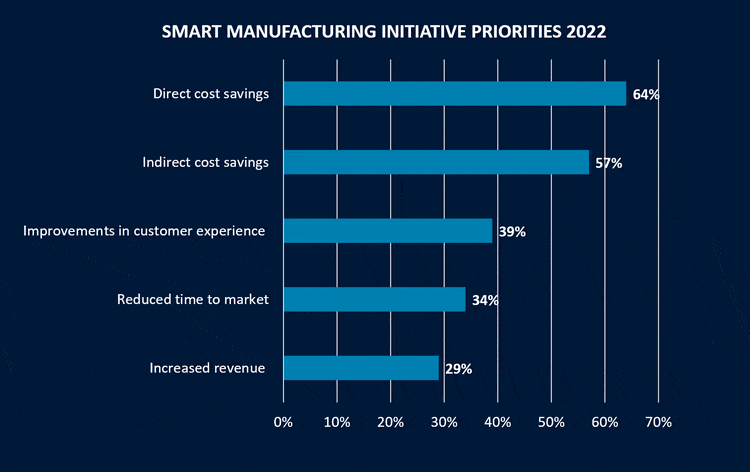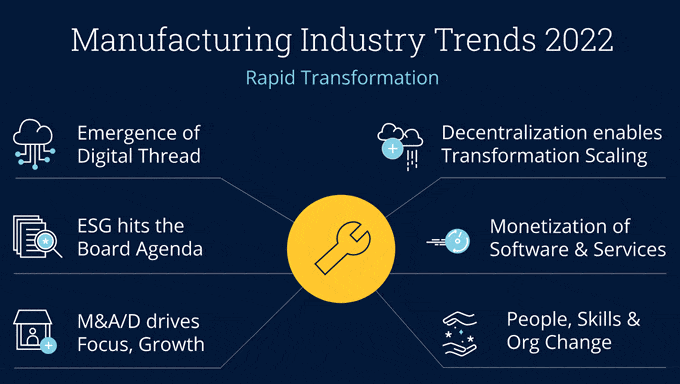A look at the 2022 ISG Global Smart Manufacturing Pulse Survey and how the adoption of smart manufacturing evolves, including priorities and challenges.
Over the past two years, organizations accelerated their digitization and digital transformation efforts in various domains at the same time. Yet, what about the more extensive change programs and visions that had slowly started before the COVID-19 pandemic and need more time and dedication as they consist of several stages, focus more on the longer term and are strategically important?

What about, for example, the Industry 4.0 vision as a broader industrial transformation strategy of the manufacturing industry with smart industry and smart manufacturing?
An enterprise priority but still early days and slow adoption
There is still a lot of interest in smart manufacturing as a concept. However, its adoption is quite slow, and many organizations are still struggling with it, a new survey says. An overview.
Previously, we wrote about how after the turbulent years of 2020 and 2021, the embracing of Industrial IoT still is slow. At the same time, faster adoption could have better responded to value and supply chain challenges.
The 2022 ISG Global Smart Manufacturing Pulse Survey found nearly three-quarters of respondents (73 percent) have less than two years of ongoing smart manufacturing experience. And 70 percent say they are making slow to minimal progress on their smart manufacturing roadmap.
As could be expected, the same happens with smart manufacturing, which is a concept that requires various technologies such as IoT technologies and data-related technologies, and also moves slower than anticipated a bit everywhere.
One might think that the COVID-19 pandemic and multiple other challenges in relationship with it are the main reasons the adoption of smart manufacturing is slow. However, according to a survey conducted by technology research and advisory firm ISG (Information Services Group) on the occasion of its ISG TechXchange: Smart Manufacturing event on April 21, 2022, the slow implementation of the concept is more related to the fact that it’s still new for most.
According to Prashant Kelker of ISG, who presented the research results in a keynote at the event, smart manufacturing, as mentioned, is and remains a top enterprise priority despite the slow acceptance and struggles.
The state of smart manufacturing in 2022: priorities
Let’s look at some of the 2022 ISG Global Smart Manufacturing Pulse Survey results, starting with the priorities.
As you know, there have been – and are – similar terms for this concept, including Industry 4.0, so it isn’t a surprise that the top objectives of manufacturing companies are pretty much the same.
The survey findings, released at the ISG TechXchange: Smart Manufacturing event, show that DIRECT cost savings rank first with 64 percent of respondents, followed by INDIRECT cost savings (57 percent). Examples of achieving the latter include waste reduction and sustainability measures.

With direct and indirect cost savings being by far the top smart manufacturing objectives of those surveyed, we are indeed typically in a situation of early adoption. Savings made in these stages also often are used to achieve longer-term goals. To quote Prashant Kelker: “Cost savings and waste reduction achieved by leveraging operational data yield the savings required to invest in long-term objectives.”
You can perfectly compare this with any related phenomenon we discussed earlier: Industrial IoT, Industry 4.0, or smart manufacturing and smart industry. From cost-savings and low-hanging fruit in terms of efficiency to the customer, growth, and, ultimately, new revenue sources, innovation, and often ecosystems and data-sharing (also as growth drivers). And, in turn, more is spent on optimizing operations. Prashat: “Many large companies are targeting new revenue streams from smart manufacturing, which in turn is driving spending on optimizing operations.”
With data, including the data needed for higher efficiency and thus cost savings, we also typically build the basis for those longer-term goals. Prashant: “Connected products and services that continuously adjust to customer usage will deliver significant growth dividends. Integrating that knowledge into engineering design is critical, and smart manufacturing is the means to that end.” From data to insights or knowledge and action, there is that DIKW model again.
Do note that organizations don’t always move from direct and indirect cost savings to other goals, perhaps except for the third top smart manufacturing goal (per the survey): improvements in customer experience (39 percent of respondents).
The following two objectives on the list of enterprise priorities are growth objectives such as reduced time to market (34 percent) and increased revenue (29 percent).
Despite the overall lack of experience with smart manufacturing and slow adoption rate, there is widespread interest in the concept (smart manufacturing), with 69 percent of respondents saying their organization has a dedicated structure to operate and coordinate smart manufacturing initiatives (ISG)
Intelligent manufacturing challenges and adoption 2022
Next, let’s take a quick look at where the enterprises surveyed for the 2022 ISG Global Smart Manufacturing Pulse Survey are in terms of smart manufacturing adoption and the challenges they encounter.
Per the survey, nearly three-quarters of respondents (73 percent, to be precise) have less than two years of ongoing smart manufacturing experience. Moreover, 70 percent of respondents say “they are making slow to minimal progress on their smart manufacturing roadmap.”
To conclude, some of the top challenges identified in the survey. First, organizational resistance seems to be the number one challenge for smart manufacturing initiatives, with 57 percent of respondents.
Next comes good old integration of IT and OT (34 percent of respondents), followed by technical debt and legacy equipment, a top challenge according to 30 percent of those surveyed.
The final words, commenting on some of these reported challenges, are for Prashant Kelker: “The challenge of turning a traditional shop floor into a hybrid connected workplace is daunting but doable. What often masquerades as organizational resistance may actually be gaps in talent and barriers created by legacy investments and architecture. Everyone wants to change, no one wants to be changed.”
How true indeed. Below are a few manufacturing industry trends for 2022 according to ISG.


